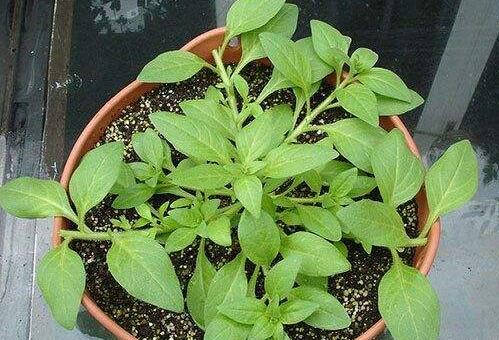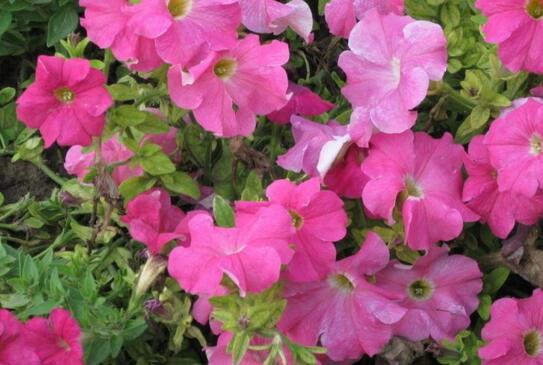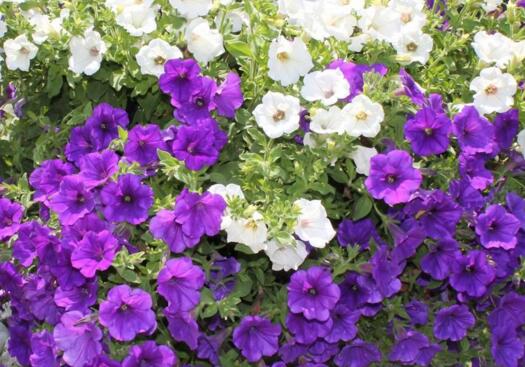How to prune petunias, petunias topping diagram/remove terminal buds/position is appropriate
Petunia has a long flowering period and high ornamental value, so it is often regarded as the king of grass and flowers. in order to have a beautiful petunia with luxuriant branches and leaves, in addition to the correct planting method, petunia also needs to hit the top at the right time, and how does petunia hit the top? Let's take a look at the picture of petunia topping.
How to hit the top of Petunia

Topping means to remove part of the leaves at the top of the plant, and the specific number depends on the growth of the plant. Generally, the number of leaves on the branches should be greater than 2 in order to ensure its normal growth and sprout more branches.
According to the experience of flower friends, the editor advises flower friends to keep 3-4 leaves when topping in spring and summer, and 4-5 leaves in autumn and winter, so that petunia sprouting too many branches at a time is disadvantageous to the balance of growth. and it is more appropriate to sprout 3-4 branches at a time.
Diagram of petunia topping
1. Remove the terminal bud
Topping is usually carried out many times in the seedling stage and growing period, in which the seedling stage is when the plant grows to more than 5 leaves, the terminal bud is removed, leaving 3-5 leaves, and then wait until the new branches grow out, and then pruned in accordance with the previous way.
2. Topping position
In the petunia topping diagram, there are generally two criteria for the selection of position, the first is the density of branches, the first is to cut off the overgrown branches. The second standard is the density and position of the branches, so that the direction and density of the branches issued by the remaining leaves should be uniform, not only the leaves on one side should be removed, otherwise the plant shape will be affected.
Pruning of Petunia
Flower friends may encounter petunia that seem to grow luxuriantly. There are still a large number of petunias at the first flowering, but then they are less. This is because the branches and leaves at the bottom do not have enough light, and only the branches at the top will form buds. So when topping, we can also cooperate with thinning to cut off some of the denser leaves, so that the buds at the bottom can enjoy plenty of sunshine.
In principle, thinning is to cut off the leaves that block the branches and buds, and the first pruning is after the first branch grows out, if the big leaves and old leaves of the trunk block the branches below, they should also be removed in time, and then maintain the right temperature. There will be a large number of flowers when it is in bloom.
Why does soybean remove the terminal bud when it is high-yielding?
[FAQ] Why do soybeans remove terminal buds? What are the methods of removing the terminal bud? What are the points for attention?
Expert answer
The terminal bud of organic soybean has strong growth ability and consumes a lot of nutrients. Removing the terminal bud of soybean to transfer the nutrients to the pod is beneficial to increase yield, especially for the organic soybean with high soil fertility and strong growth, the effect of increasing yield is more significant when the terminal bud is removed in time. The following is to introduce the new technology of organic soybean topping to increase production:
The method of removing the terminal bud of organic soybean is as follows: at the peak of soybean growth and early flowering stage, the top of the main stem is removed from 2cm to 3cm tender head, so that the top growth is inhibited, nutrients are concentrated to supply reproductive growth, promote more flowering and pod, which is beneficial to make the plant short and strong. enhance stress resistance.
The top removal of organic soybean should be "three suitable" and "three unsuitable": it should be carried out before flowering, not after flowering, fat should not be thin, plants with good fertilizer and water, high fertility and vigorous growth should be peeled, on the contrary, they should not be picked, should not be dense, and should not be peeled for densely grown plants, but should be picked at the right time for sparsely planted organic soybeans and vigorous plants, which is beneficial to increase production.
When organic soybeans bloom, spraying 0.05%-0.1% organic fertilizer at the right time has an obvious effect on increasing production.
Diagram of how to prune rubber trees
How high is the rubber tree? Pruning is recommended for how to remove the head. In order to make it grow better, the rubber tree needs to be pruned frequently. How do you trim the rubber tree? Let's learn about the pruning of rubber trees.
Pruning methods of rubber trees
1. Coring: the principle is that the apical bud of the main branch is removed and the apical advantage is eliminated, so that the lateral bud can germinate and grow. The specific approach is that when the rubber tree grows to an appropriate height, it is generally 30 to 50 centimeters high, and its upright growth can be changed by coring to promote lateral bud germination. Generally, the 2-3 lateral buds near the top of the branches are easy to germinate, and the lateral branches are cup-shaped or Y-shaped after the lateral branches grow, so it is easy to prune the rubber tree.
2. Truncation: a method of pruning the upper part of the main branch (1x3 or 1x2) to promote the sprouting of lateral branches. The principle is that the top branch is cut off and the apical advantage is eliminated so that the lateral buds under the cut can germinate and grow. This method is easy to cut off more branches and leaves in the early maintenance because of the large amount of pruning of rubber trees at one time, and it is very beneficial to the later modeling because there are fewer branches and leaves in at least half to a year.
3. Sprouting: the method of engraving the bald part of the main branch to promote the bud germination to form lateral branches, which is called sprouting. The principle is that the wound hinders the transport of nutrients and water, which generally inhibits the growth of the upper part of the wound and strengthens the growth of the lower part of the wound.
4. Branch pulling: the principle of branch pulling is to change the extension direction of the branch in space by external force, that is, to weaken or eliminate the top advantage of the top bud, the larger the angle of the branch, the stronger the tip advantage is weakened. if pulled to the horizontal state, the top advantage is completely eliminated. The specific operation is: pull the bud into an arc, so that the bud is in the top dominant position, if the branch is pulled in spring, it can promote the formation of lateral branches in the same year.
5. Precautions: in the actual operation of the pruning of rubber trees, the appropriate parts should be selected according to the needs of modeling. When the angle of the branches is too large due to the sprouting, the method of supporting branches can be used to make the branches to a suitable angle. Scratching is mainly used for strong branches, rough, thin and weak branches.
6. Techniques for shaping and pruning lateral branches: rubber trees have strong apical advantages, and lateral buds are generally not easy to germinate. if they are not reshaped, they are easy to grow upright upward and form an upright shape. When growing to a certain height, first, it is too tall and inconvenient to be placed indoors, and second, after the lower leaves fall off, it is easy to become the upper branches and leaves luxuriant, the lower bald upper heavy and lower light shape, losing the ornamental value. This paper introduces several simple and easy methods to restrain its height growth and promote the change of lateral branch shape.
7. The pruning season of rubber trees: the pruning of rubber trees should pay attention to "winter pruning, summer control". That is, heavy pruning of strong trees and light pruning of weak trees in winter, with emphasis on pruning upright and strong competitive branches from the base. In summer, the pruning of rubber trees should be carried out to re-control the strong branches, control the strong and retain the weak, adjust the balance of the tree situation, and master the principles of strong side strike, heavy pruning of strong branches, light pruning of weak branches and more twigs, so as to achieve the pruning purpose of highlighting the trunk and promoting the growth of trees.
The above is the rubber tree pruning method is introduced, in order to rubber tree better growth and improve ornamental value, to regular rubber tree pruning oh.
- Prev

How to water the petunia, how often to water the petunia / the soil surface is white / do not accumulate water
When planting petunia, moisture is related to its growth speed, and even affects its health. If the soil is too moist, its roots will rot and age, and too dry will make the roots grow badly, so watering must be done well. So how do petunia water? The editor came to tell you the watering skills.
- Next

What to do with petunia wilting? stagnant water is the main reason / scientific watering pay attention to waterlogging prevention.
The planting method of petunia is relatively easy, as long as there is enough light and moist environment, it can grow very fast, but sometimes the plant will wither and wilt because the details are not done well, which makes some flower friends have a headache.
Related
- Fuxing push coffee new agricultural production and marketing class: lack of small-scale processing plants
- Jujube rice field leisure farm deep ploughing Yilan for five years to create a space for organic food and play
- Nongyu Farm-A trial of organic papaya for brave women with advanced technology
- Four points for attention in the prevention and control of diseases and insect pests of edible fungi
- How to add nutrient solution to Edible Fungi
- Is there any good way to control edible fungus mites?
- Open Inoculation Technology of Edible Fungi
- Is there any clever way to use fertilizer for edible fungus in winter?
- What agents are used to kill the pathogens of edible fungi in the mushroom shed?
- Rapid drying of Edible Fungi

